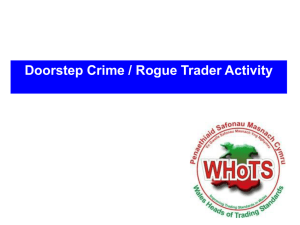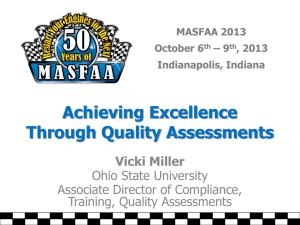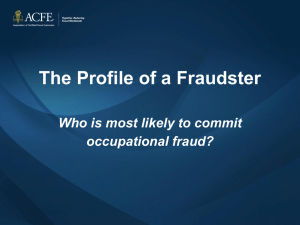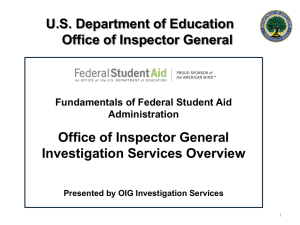Grand Canyon University
advertisement
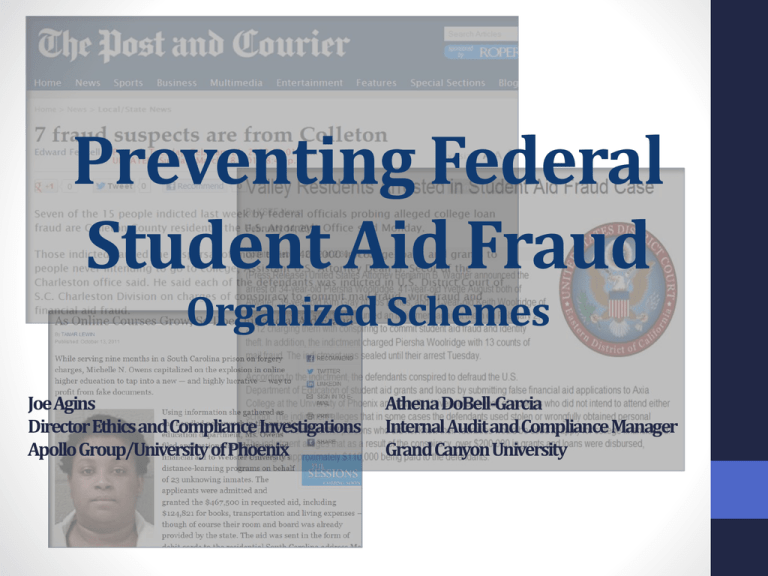
Preventing Federal Student Aid Fraud Organized Schemes Joe Agins Director Ethics and Compliance Investigations Apollo Group/University of Phoenix Athena DoBell-Garcia Internal Audit and Compliance Manager Grand Canyon University Agenda Apollo/University of Phoenix • SFA Fraud in the News • Regulatory References • Fraud Scheme Characteristics • Prevention Techniques • Measuring Success • Partnership with Law Enforcement • School Coalition Grand Canyon University Prevention Techniques Detection Techniques Audit Process Review and Research Examples • Tracking Our Progress • • • • SFA Fraud in the News SFA Fraud in the News (Video) SFA Fraud in the News Regulatory References In Summary • US Department of Education > Standards of Administrative Capability > Resolving Conflicting Data • C.F.R § 668.16(f) – An institution must develop and apply an adequate system to identify and resolve discrepancies in the information that the institution receives from different sources with respect to a student's application for financial aid under Title IV, HEA programs… • C.F.R § 668.16(g) – An institution has an obligation to refer to the Office of the Inspector General of the Department of Education for investigation any credible information indicating that an applicant for Title IV may have engaged in fraud or other criminal conduct… Regulatory References In Summary • Fighting Fraud With the Red Flags Rule • Issued by the Federal Trade Commission (FTC) • Requires many businesses and organizations to implement a written Identity Theft Prevention Program designed to detect the warning signs — or "red flags" — of identity theft in their day-today operations. By identifying red flags in advance, businesses will be better equipped to spot suspicious patterns that may arise -- and take steps to prevent a red flag from escalating into a costly episode of identity theft. Fraud Scheme Characteristics • Participants provide personal info to Ring Leader, who will register for school, apply for SFA, and “do all of the homework” to maintain attendance until SFA funds are disbursed • Once funds are disbursed, Ring Leader and participant split the funds, stop attending, and student is not heard from again • Scheme ring leaders often attend school themselves as well as helping recruits to attend fraudulently • Ring leaders will also set up student accounts with stolen identities to avoid having to split the proceeds Fraud Scheme Characteristics • Schemes typically target online and the less-expensive and/or twoyear “entry level” programs • Fraud “Ring Leader” recruits participants enticing them with an opportunity for free money • Scheme participants typically target vulnerable populations (e.g. younger persons and/or in economically depressed areas) • Most participants never graduated high school or completed a GED program but falsify admissions • Ring Leader often sets student accounts up with one or a few common addresses/phone numbers/emails Apollo Group/University of Phoenix Prevention Techniques: General Actions Taken • AEC team consisting of three FTEs dedicated to the anti-fraud effort • Ancillary benefit of University Orientation course: Deterrent to fraud • University Orientation is a 3 week, no cost, non-credit course required for all new students with less than 24 college credits. Opportunity to “test drive” the University to determine if they are ready for the academic rigor. • SFA suspected fraud scheme intake form created for employees to submit issues or suspicious activity • Employee education and awareness campaign launched including numerous trainings, teleconferences, job aids, compliance alerts, etc. regarding how to detect and report suspected SFA fraud students Apollo Group/University of Phoenix Prevention Techniques: IT Initiatives • Datamart developed to house suspected fraud student information • Fraud-detection reports developed for regular delivery and review: • Duplicate Demographic Report: identifies 4+ matches on address, phone, or email (all 4 must have completed an app) • Duplicate Direct Deposit Report: identifies 3+ students with same bank account info on FAW (for receipt of SFA refunds) • Duplicate IP Address Report: identifies 4+ students using the same IP address to e-sign the admissions application • Reverse Look-up (RL) Reports: three weekly RL reports identify new matches to current fraudsters on the matching elements mentioned above • Death Master File: compares student SSNs with SSNs on the Social Security Administration (SSA)’s Death Master list- if there is a match, and that match has positive attendance that occurred >10 days after the date of death (per the SSA), student is identified on the DMF report • Other potential “linking “ elements: students being on each other’s FERPA releases or verification worksheets, submitting the same schoolwork, etc. Apollo Group/University of Phoenix SFA Fraud Student Management Process Students are transferred to specialized fraud employee team, SFA files are placed on hold, and schedules are changed to prevent class start, if possible. AEC is notified of potential fraud via campus or internal reports. AEC reviews group and determines if it meets established fraud scheme criteria. After 30 days, if majority of group submitted all valid documents, AEC rereviews group for possible reversal. Students have 30 days to complete internal review process by submitting various identity verification documents. If group does not meet reversal criteria or majority of group did not submit all valid documents, scheme is referred to the DOE-OIG. Apollo Group/University of Phoenix Prevention Techniques: Fraud Student Management Process • Dedicated team of counselors created to manage suspected fraud student population • Institution self-selects for additional verification: INTREV (internal review) process implemented requiring suspected fraud students to complete an extensive identity verification process to receive SFA • stops bad actors, permits good actors to proceed • If not initially flagged, reviewed students might still be put on “Watch” (regularly reviewed for new matches/info that might prompt later flag) Apollo Group/University of Phoenix Prevention Techniques: Referral to the OIG • Referral info is burned to a DVD and shipped to the OIG (Personal Identifier Information protected). Referral package for each scheme includes but is not limited to: • Spreadsheet of student info • Student documents (e.g. admissions app, financial agreement, verification worksheet, etc.) • Student ISIRs, cancelled check copies, SFA refund transaction log • Internal Review (INTREV) documents (examples on next slide) • Any additional info (e.g. Student Code of Conduct charge letters, recorded phone calls, etc.) Apollo Group/University of Phoenix Examples of fraudulent documents sent to the OIG: Apollo Group/University of Phoenix Examples of fraudulent documents sent to the OIG: Apollo Group/University of Phoenix Measuring Success • “Catch Rate” = # of flagged students “caught” Total # of Flagged students • “# caught” refers to fraudsters flagged PRIOR to any SFA being disbursed • Remaining fraudsters were flagged AFTER SFA already disbursed and so considered not “caught” • Developed to measure Fraud Squad success • Consistently high - 78% monthly average over past 12 months Apollo Group/University of Phoenix Partnership with Law Enforcement • Dedicate adequate resources to the effort • Successful program demands healthy relationship with the OIG. Regular communication is key. • discuss national fraud trends and best practices • understand the types of information the OIG and the U.S. Attorney’s office will need to identify and prosecute individuals involved • “The squeaky wheel gets the grease”, as do those cases with the best info • More detailed and higher quality referrals result in more prosecutions • Many fraudsters also involved in numerous other crimes – mail fraud, passport fraud, mortgage fraud, social security fraud, ID theft, etc. • Other investigative resources besides OIG – Postal Inspectors. School Coalition Grand Canyon University Prevention Techniques • Two team members (additional job duties include Title IV Compliance Audits and Operational Audits) • Speak with new hires during compliance training/periodic refreshers • Work with counselors to help get the word out • Work with AVP’s, Director’s, and Managers • GCU Intranet has Internal Audit site that provides team contact information • Run advanced finds on high risk areas Grand Canyon University Detection Techniques • Fraud-detection reports and notifications Duplicate demographic report (address, phone, email) Referral reports Needs correction report Office of Academic Records provides discrepancies on applications (example: conflicting YOB and Graduation year, type of diploma and place of graduation) • Counselor inquiries • Faculty inquiries • Address change report • • • • Grand Canyon University Audit Process • Notified of possible issue or possible issue is located in the reports • Log the issue in our database • Review and research • Application, documentation provided by student, internal notes, listen to recorded calls, phone interview with student, external websites to identify additional ‘Red Flags’ • Possible next steps • Internal Review Notification (Internal Audit Hold) • Letter from Internal Audit asking the potential student or student to provide additional documentation to determine eligibility • The Internal Audit Hold stops future disbursements on the account • Counselor Request Notification • Internal Audit notifies the counselor to request additional documentation Grand Canyon University Review and Research Grand Canyon University Review and Research Grand Canyon University Review and Research Grand Canyon University Audit Process • Once review is complete: • If we find issues with provided documentation – We present our findings to management, General Counsel and the VP of Academic Compliance • If the documentation is accepted – the hold is lifted, the student is allowed to proceed • If we believe misuse/fraud of financial aid may have occurred, communication is made with the appropriate OIG representative • Database is updated to reflect course of action taken Grand Canyon University Tracking Our Progress • Tracking began January, 2013 for volume of notifications received • January and February 148 cases opened • Approximately 29% were pulled prior to incurring any charges • Our progress is tracked by category (examples of some categories and count) • • • • Transcript/application issue (31) Lead rings (63) Stipend use (1) Identity theft (5) Any questions? Contact Information Joe Agins Director, Ethics & Compliance Investigation Apollo Group/University of Phoenix 602-557-3535 Joseph.agins@apollogrp.edu Athena DoBell-Garcia Internal Audit and Compliance Manager Grand Canyon University 602-639-7752 Athena.DoBell-Garcia@gcu.edu Additional Resources http://www.drive rslicenseguide.co m/book-us.html http://www.ice. gov/hsi-fl/





